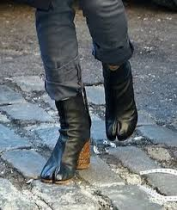
The god who sits cross-legged: you know Who I mean. The position is central to the iconography of the Horned, in art both ancient and modern. In Old Craft symbolism, the Master may be represented by the skull of a horned animal with two longbones crossed beneath it. If Witchdom had pirates (!), I suppose that's what they'd fly on their flags. The Lord of the Red Bones, above and below.
Even in images such as Lévi's Baphomet and the Gundestrup Antlered, where the god is seated in a position not fully “tailor seat” (as we used to call it), his crossed or bent legs at least allude to the fully cross-legged seat. It's well worth asking what this pose can tell us about the god.
Nature. Civilized people (and their gods) sit on furniture. Barbarians sit on the ground, and cross-legged is the natural way to do so. This is an untamed god, a god in touch with the powers of nature, drawing strength and stability from the Earth.
Duality. The iconography of the Horned lord is dominated by doubling, and this speaks deeply to His nature. He is both Dark and Light, Lord of life and death, the master driven by his own internal contradictions. (Whereas Wicca tends to read duality in terms of male-female pairing, Old Craft generally looks to the divided self for the primal articulation of Twoness.) Just as his legs cross beneath him, so too do the two sides of his self cross and intersect with one another, the basis of his Being.

















